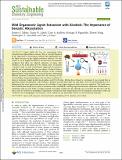Files in this item
Mild organosolv lignin extraction with alcohols : the importance of benzylic alkoxylation
Item metadata
| dc.contributor.author | Zijlstra, Douwe S. | |
| dc.contributor.author | Lahive, Ciaran | |
| dc.contributor.author | Analbers, Coen A. | |
| dc.contributor.author | Figueiredo, Monique Bernardes | |
| dc.contributor.author | Wang, Zhiwen | |
| dc.contributor.author | Lancefield, Chris | |
| dc.contributor.author | Deuss, Peter J. | |
| dc.date.accessioned | 2020-05-07T11:30:03Z | |
| dc.date.available | 2020-05-07T11:30:03Z | |
| dc.date.issued | 2020-04-06 | |
| dc.identifier | 267818959 | |
| dc.identifier | 27558ec8-bf91-43c0-b1af-fe31d17549b7 | |
| dc.identifier | 000526363600015 | |
| dc.identifier | 85084174920 | |
| dc.identifier.citation | Zijlstra , D S , Lahive , C , Analbers , C A , Figueiredo , M B , Wang , Z , Lancefield , C & Deuss , P J 2020 , ' Mild organosolv lignin extraction with alcohols : the importance of benzylic alkoxylation ' , ACS Sustainable Chemistry & Engineering , vol. 8 , no. 13 , pp. 5119-5131 . https://doi.org/10.1021/acssuschemeng.9b07222 | en |
| dc.identifier.issn | 2168-0485 | |
| dc.identifier.uri | https://hdl.handle.net/10023/19899 | |
| dc.description | C.S.L. thanks the Leverhulme Trust Early Career Fellowship (ECF-2018-480). Z.W. acknowledges the China Scholarship Council for funding (grant number 201706300138). | en |
| dc.description.abstract | Lignin holds the key for maximizing value extraction from lignocellulosic biomass. This is currently hindered by the application of fractionation methods that significantly alter the lignin structure to give highly recalcitrant materials. For this reason, it can be highly beneficial to use less-severe fractionation conditions that allow for efficient extraction of lignin with retention of the β-aryl ether (β-O-4) content. Here, we present a detailed study on mild alcohol-based organosolv fractionation with the aim of understanding how to achieve a balance between efficiency of lignin extraction and the structure of the resulting lignin polymers, using walnut shells as model biomass. Monitoring different extraction conditions reveals how the structure of the extracted lignin changes depending on the extraction conditions in terms of molecular weight, alcohol incorporation, and H/G/S ratios. Moving from ethanol to n-pentanol, it was revealed that, in particular, alcohol incorporation at the benzylic α-position of β-aryl ether units not only plays a key role in protecting the β-O-4 linking motif but more importantly increases the solubility of larger lignin fragments under extraction conditions. This study shows that α-substitution already occurs prior to extraction and is essential for reaching improved extraction efficiencies. Furthermore, α-substitution with not only bulky secondary alcohols and tertiary alcohols but also chloride was revealed for the first time and the latter could be involved in facilitating α-alkoxylation. Overall, this study demonstrates how by tuning the fractionation setup and conditions, the resulting lignin characteristics can be influenced and potentially tailored to suit downstream demands. | |
| dc.format.extent | 13 | |
| dc.format.extent | 4421431 | |
| dc.language.iso | eng | |
| dc.relation.ispartof | ACS Sustainable Chemistry & Engineering | en |
| dc.subject | Lignin | en |
| dc.subject | Mild organosolv extraction | en |
| dc.subject | Benzvlic alkoxvlation | en |
| dc.subject | β-O-4 retention | en |
| dc.subject | Solvent effects | en |
| dc.subject | QD Chemistry | en |
| dc.subject | DAS | en |
| dc.subject.lcc | QD | en |
| dc.title | Mild organosolv lignin extraction with alcohols : the importance of benzylic alkoxylation | en |
| dc.type | Journal article | en |
| dc.contributor.sponsor | The Leverhulme Trust | en |
| dc.contributor.institution | University of St Andrews. School of Chemistry | en |
| dc.identifier.doi | 10.1021/acssuschemeng.9b07222 | |
| dc.description.status | Peer reviewed | en |
| dc.identifier.grantnumber | ECF-2018-480 | en |
This item appears in the following Collection(s)
Items in the St Andrews Research Repository are protected by copyright, with all rights reserved, unless otherwise indicated.

